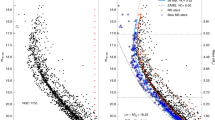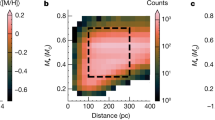Abstract
The stellar initial mass function (IMF) describes the mass distribution of stars at the time of their formation and is of fundamental importance for many areas of astrophysics. The IMF is reasonably well constrained in the disk of the Milky Way1 but we have very little direct information on the form of the IMF in other galaxies and at earlier cosmic epochs. Here we report observations of the Na i doublet2,3 and the Wing–Ford molecular FeH band4,5 in the spectra of elliptical galaxies. These lines are strong in stars with masses less than 0.3M⊙ (where M⊙ is the mass of the Sun) and are weak or absent in all other types of stars5,6,7. We unambiguously detect both signatures, consistent with previous studies8 that were based on data of lower signal-to-noise ratio. The direct detection of the light of low-mass stars implies that they are very abundant in elliptical galaxies, making up over 80% of the total number of stars and contributing more than 60% of the total stellar mass. We infer that the IMF in massive star-forming galaxies in the early Universe produced many more low-mass stars than the IMF in the Milky Way disk, and was probably slightly steeper than the Salpeter form9 in the mass range 0.1M⊙ to 1M⊙.
This is a preview of subscription content, access via your institution
Access options
Subscribe to this journal
Receive 51 print issues and online access
$199.00 per year
only $3.90 per issue
Buy this article
- Purchase on Springer Link
- Instant access to full article PDF
Prices may be subject to local taxes which are calculated during checkout


Similar content being viewed by others
References
Kroupa, P. On the variation of the initial mass function. Mon. Not. R. Astron. Soc. 322, 231–246 (2001)
Faber, S. M. & French, H. B. Possible M dwarf enrichment in the semistellar nucleus of M31. Astrophys. J. 235, 405–412 (1980)
Schiavon, R. P., Barbuy, B., Rossi, S. C. F. & Milone, A. The near-infrared Na i doublet feature in M stars. Astrophys. J. 479, 902–908 (1997)
Wing, R. F. & Ford, W. K. The infrared spectrum of the cool dwarf Wolf 359. Publ. Astron. Soc. Pacif. 81, 527–529 (1969)
Schiavon, R. P., Barbuy, B. & Singh, P. D. The FeH Wing-Ford band in spectra of M stars. Astrophys. J. 484, 499–510 (1997)
Schiavon, R. P., Barbuy, B. & Bruzual, A. G. Near-infrared spectral features in single-aged stellar populations. Astrophys. J. 532, 453–460 (2000)
Cushing, M. C., Rayner, J. T., Davis, S. P. & Vacca, W. D. FeH absorption in the near-infrared spectra of late M and L dwarfs. Astrophys. J. 582, 1066–1072 (2003)
Couture, J. & Hardy, E. The low-mass stellar content of galaxies—constraints through hybrid population synthesis near 1 micron. Astrophys. J. 406, 142–157 (1993)
Salpeter, E. E. The luminosity function and stellar evolution. Astrophys. J. 121, 161–167 (1955)
Oke, J. B. et al. The Keck low-resolution imaging spectrometer. Publ. Astron. Soc. Pacif. 107, 375–385 (1995)
Baugh, C. M. et al. Can the faint submillimetre galaxies be explained in the Λ cold dark matter model? Mon. Not. R. Astron. Soc. 356, 1191–1200 (2005)
Conroy, C., Gunn, J. E. & White, M. The propagation of uncertainties in stellar population synthesis modeling. I. The relevance of uncertain aspects of stellar evolution and the initial mass function to the derived physical properties of galaxies. Astrophys. J. 699, 486–506 (2009)
Rayner, J. T., Cushing, M. C. & Vacca, W. D. The Infrared Telescope Facility (IRTF) spectral library: cool stars. Astrophys. J. Suppl. 185 289–432 (2009)
van Dokkum, P. G. Evidence of cosmic evolution of the stellar initial mass function. Astrophys. J. 674, 29–50 (2008)
Fardal, M. A., Katz, N., Weinberg, D. H. & Davé, R. On the evolutionary history of stars and their fossil mass and light. Mon. Not. R. Astron. Soc. 379, 985–1002 (2007)
Davé, R. The galaxy stellar mass-star formation rate relation: evidence for an evolving stellar initial mass function? Mon. Not. R. Astron. Soc. 385, 147–160 (2008)
Naab, T., Johansson, P. H., Ostriker, J. P. & Efstathiou, G. Formation of early-type galaxies from cosmological initial conditions. Astrophys. J. 658, 710–720 (2007)
van Dokkum, P. G. et al. The growth of massive galaxies since z = 2. Astrophys. J. 709, 1018–1041 (2010)
Boroson, T. A. & Thompson, I. B. Color distributions in early type galaxies. III – Radial gradients in spectral features. Astron. J. 101, 111–126 (1991)
Cenarro, A. J., Gorgas, J., Vazdekis, A., Cardiel, N. & Peletier, R. F. Near-infrared line-strengths in elliptical galaxies: evidence for initial mass function variations? Mon. Not. R. Astron. Soc. 339, L12–L16 (2003)
Carter, D. Visvanathan, N. & Pickles, A. J. The dwarf star content of elliptical and lenticular galaxies. Astrophys. J. 311, 637–650 (1986)
Treu, T. et al. The initial mass function of early-type galaxies. Astrophys. J. 709, 1195–1202 (2010)
Calchi Novati, S. & de Luca, F. Jetzer, Ph. Mancini, L. & Scarpetta, G. Microlensing constraints on the Galactic bulge initial mass function. Astron. Astrophys. 480, 723–733 (2008)
van der Wel, A. et al. Recent structural evolution of early-type galaxies: size growth from z = 1 to z = 0. Astrophys. J. 688, 48–58 (2008).
Larson, R. B. Thermal physics, cloud geometry and the stellar initial mass function. Mon. Not. R. Astron. Soc. 359, 211–222 (2005)
Bate, M. R. & Bonnell, I. A. The origin of the initial mass function and its dependence on the mean Jeans mass in molecular clouds. Mon. Not. R. Astron. Soc. 356, 1201–1221 (2005)
Bonnell, I. A., Clark, P. & Bate, M. R. Gravitational fragmentation and the formation of brown dwarfs in stellar clusters. Mon. Not. R. Astron. Soc. 389, 1556–1562 (2008)
Schneider, R. & Omukai, K. Metals, dust and the cosmic microwave background: fragmentation of high-redshift star-forming clouds. Mon. Not. R. Astron. Soc. 402, 429–435 (2010)
Banerji, S., Viti, S., Williams, D. A. & Rawlings, J. M. C. Timescales for low-mass star formation in extragalactic environments: implications for the stellar initial mass function. Astrophys. J. 692, 283–289 (2009)
Labbé, I. et al. Star formation rates and stellar masses of z = 7–8 galaxies from IRAC observations of the WFC3/IR Early Release Science and the HUDF fields. Astrophys. J. 716, L103–L108 (2010)
Acknowledgements
We thank R. Bezanson, J. Brinchmann, R. Larson and R. Zinn for discussions. We thank R. Schiavon for comments that improved the manuscript. This study is based on observations obtained at the W. M. Keck Observatory. We recognize and acknowledge the very significant cultural role and reverence that the summit of Mauna Kea has always had within the indigenous Hawaiian community and consider ourselves fortunate to have the opportunity to conduct observations from this mountain.
Author information
Authors and Affiliations
Contributions
P.G.v.D. obtained and analysed the data and contributed to the analysis and interpretation. C.C. constructed the stellar population synthesis models and contributed to the analysis and interpretation.
Corresponding author
Ethics declarations
Competing interests
The authors declare no competing financial interests.
Supplementary information
Supplementary Information
The file contains Supplementary Text on stellar population synthesis modelling, additional references and Supplementary Figures 1-2 with legends. (PDF 203 kb)
PowerPoint slides
Rights and permissions
About this article
Cite this article
van Dokkum, P., Conroy, C. A substantial population of low-mass stars in luminous elliptical galaxies. Nature 468, 940–942 (2010). https://doi.org/10.1038/nature09578
Received:
Accepted:
Published:
Issue Date:
DOI: https://doi.org/10.1038/nature09578
This article is cited by
-
Stellar initial mass function varies with metallicity and time
Nature (2023)
-
Virial models and anisotropy of velocity dispersion in E-galaxies
Astrophysics and Space Science (2020)
-
The Origin of the Stellar Mass Distribution and Multiplicity
Space Science Reviews (2020)
-
Star Clusters Near and Far
Space Science Reviews (2020)
-
Enrichment of the Hot Intracluster Medium: Observations
Space Science Reviews (2018)
Comments
By submitting a comment you agree to abide by our Terms and Community Guidelines. If you find something abusive or that does not comply with our terms or guidelines please flag it as inappropriate.



